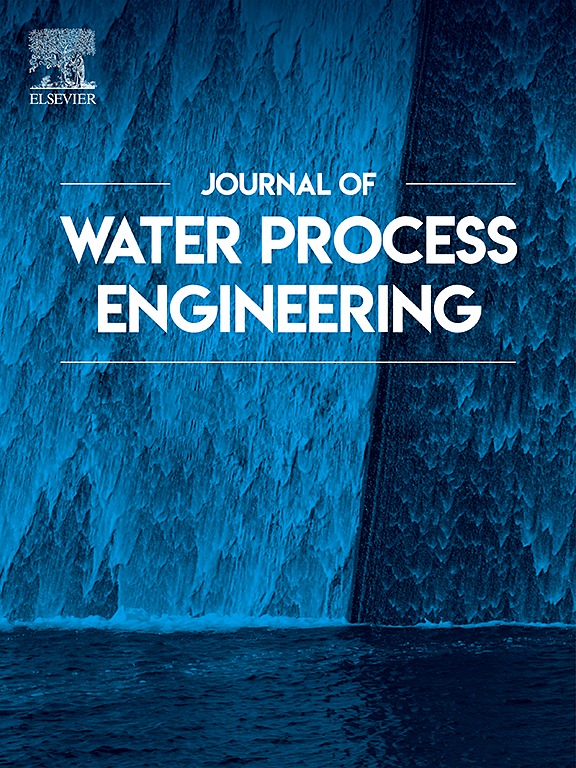Efficient adsorption of tetracycline by phytic acid modulated ramie fiber-derived porous carbon: Performance, mechanism, and application potential
IF 6.3
2区 工程技术
Q1 ENGINEERING, CHEMICAL
引用次数: 0
Abstract
Tetracyclines are widely adopted in various industries and ubiquitous in wastewater, and developing efficient removal technologies remains a challenge. In this study, a phytic acid pre-modulated porous carbon originating from ramie fiber (PARPC) was prepared to remove tetracycline from water. Batch experiments showed that PARPC had excellent adsorption capacity (Qmax = 520.47 mg/g) for TC, whereas the adsorption of TC by the carbon material without PA pretreatment (RPC) was almost negligible. Various coexisting substances (sulfate, nitrate, chloride, phosphate, carbonate, and humic acid) had a negligible effect on the adsorption of TC by PARPC. FTIR, XPS, and DFT analysis indicated that π-π bonding and C-O-P formation were responsible for TC adsorption. The fix-bed system further verified that PARPC was capable of continuously treating TC-containing wastewater for >600-bed volume (BV). The depleted PARPC was completely regenerated by NaOH solution without significant reduction in treating capacity. This study not only presents a novel concept for preparing functional adsorbent, but also offers an effective solution for addressing antibiotic pollutants in aqueous environments.

植酸调控苎麻纤维衍生多孔炭对四环素的高效吸附:性能、机理及应用潜力
四环素被广泛应用于各行各业,在废水中也无处不在,开发高效的去除技术仍然是一个挑战。在本研究中,制备了一种源自苎麻纤维的植酸预调制多孔碳(PARPC)来去除水中的四环素。批量实验结果表明,PARPC对TC具有优良的吸附能力(Qmax = 520.47 mg/g),而未经PA预处理的炭材料(RPC)对TC的吸附几乎可以忽略不计。多种共存物质(硫酸盐、硝酸盐、氯化物、磷酸盐、碳酸盐和腐植酸)对PARPC吸附TC的影响可以忽略不计。FTIR, XPS和DFT分析表明,π-π键和C-O-P的形成是吸附TC的主要原因。固定床系统进一步验证了PARPC能够连续处理600床容积(BV)的含tc废水。耗尽的PARPC在NaOH溶液中完全再生,处理能力没有明显降低。本研究不仅提出了功能吸附剂制备的新概念,而且为处理水环境中抗生素污染物提供了有效的解决方案。
本文章由计算机程序翻译,如有差异,请以英文原文为准。
求助全文
约1分钟内获得全文
求助全文
来源期刊

Journal of water process engineering
Biochemistry, Genetics and Molecular Biology-Biotechnology
CiteScore
10.70
自引率
8.60%
发文量
846
审稿时长
24 days
期刊介绍:
The Journal of Water Process Engineering aims to publish refereed, high-quality research papers with significant novelty and impact in all areas of the engineering of water and wastewater processing . Papers on advanced and novel treatment processes and technologies are particularly welcome. The Journal considers papers in areas such as nanotechnology and biotechnology applications in water, novel oxidation and separation processes, membrane processes (except those for desalination) , catalytic processes for the removal of water contaminants, sustainable processes, water reuse and recycling, water use and wastewater minimization, integrated/hybrid technology, process modeling of water treatment and novel treatment processes. Submissions on the subject of adsorbents, including standard measurements of adsorption kinetics and equilibrium will only be considered if there is a genuine case for novelty and contribution, for example highly novel, sustainable adsorbents and their use: papers on activated carbon-type materials derived from natural matter, or surfactant-modified clays and related minerals, would not fulfil this criterion. The Journal particularly welcomes contributions involving environmentally, economically and socially sustainable technology for water treatment, including those which are energy-efficient, with minimal or no chemical consumption, and capable of water recycling and reuse that minimizes the direct disposal of wastewater to the aquatic environment. Papers that describe novel ideas for solving issues related to water quality and availability are also welcome, as are those that show the transfer of techniques from other disciplines. The Journal will consider papers dealing with processes for various water matrices including drinking water (except desalination), domestic, urban and industrial wastewaters, in addition to their residues. It is expected that the journal will be of particular relevance to chemical and process engineers working in the field. The Journal welcomes Full Text papers, Short Communications, State-of-the-Art Reviews and Letters to Editors and Case Studies
 求助内容:
求助内容: 应助结果提醒方式:
应助结果提醒方式:


